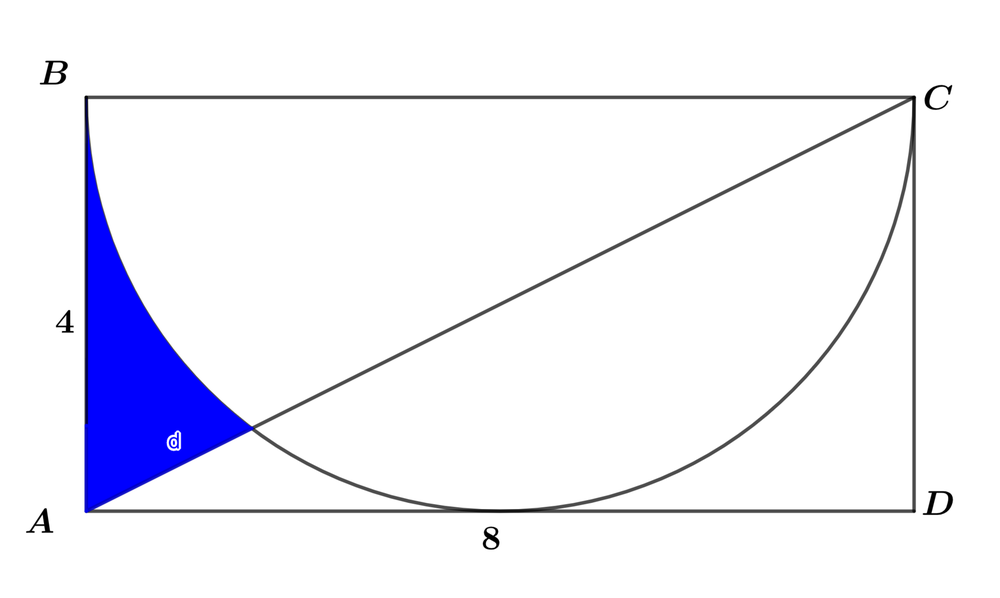It's all Volumes

If the shaded region in rectangle above with diagonal and inscribed semicircle whose diameter is is revolved about the line , then the resulting volume can be represented as , where , and are coprime positive integers.
Find .
The answer is 10.
This section requires Javascript.
You are seeing this because something didn't load right. We suggest you, (a) try
refreshing the page, (b) enabling javascript if it is disabled on your browser and,
finally, (c)
loading the
non-javascript version of this page
. We're sorry about the hassle.
Using the diagram above the equation of line A C is y = 2 1 x or x = 2 y and for the circle centered at (4,4) with have ( x − 4 ) 2 + ( y − 4 ) 2 = 1 6
x = 2 y ⟹ ( 2 y − 4 ) 2 + ( y − 4 ) 2 = 1 6 ⟹ 5 y 2 − 2 4 y + 1 6 = 0 ⟹
y = 5 4 , y = 4 Since we already have ( 8 , 4 ) ⟹ P ( 5 8 , 5 4 )
So the volume of the pink region when revolved about the y axis is the volume of the cone
V 1 = 3 1 ( 5 8 ) 2 ( 5 4 ) π = 3 7 5 2 5 6 π .
( x − 4 ) 2 + ( y − 4 ) 2 = 1 6 ⟹ x = 4 − 1 6 − ( y − 4 ) 2 which is the portion of the circle needed.
V 2 = π ∫ 5 4 4 ( 4 − 1 6 − ( y − 4 ) 2 ) 2 d y =
π ∫ 5 4 4 ( 3 2 − ( y − 4 ) 2 − 8 1 6 − ( y − 4 ) 2 ) d y
∫ 5 4 4 ( 3 2 − ( y − 4 ) 2 ) d y = 3 2 y − 3 ( y − 4 ) 3 ∣ 5 4 4 = 3 7 5 3 4 3 0 4
For I = ∫ 1 6 − ( y − 4 ) 2 d y
Let y − 4 = 4 sin ( θ ) ⟹ d y = 4 cos ( θ ) ⟹ I = 8 ∫ ( 1 + cos ( 2 θ ) ) d θ
= 8 ( θ + sin ( θ ) cos ( θ ) ) = 8 ( arcsin ( 4 y − 4 ) + 1 6 ( y − 4 ) 1 6 − ( y − 4 ) 2 )
⟹ ∫ 5 4 4 ( 1 6 − ( y − 4 ) 2 ) d y = 8 arcsin ( 5 4 ) + 2 5 9 6
⟹ V 2 = π ( 3 7 5 3 4 3 0 4 − 6 4 arcsin ( 5 4 ) − 2 5 7 6 8 ) = π ( 3 7 5 2 2 7 8 4 − 6 4 arcsin ( 5 4 ) )
⟹ V = V 1 + V 2 = π ( 3 7 5 2 5 6 + 3 7 5 2 2 7 8 4 − 6 4 arcsin ( 5 4 ) ) = 6 4 π ( 2 5 2 4 − arcsin ( 5 4 ) ) =
2 2 ∗ 3 ( 5 2 2 3 ∗ 3 − arcsin ( 5 2 2 ) ) π = a a ∗ b ( c a a b ∗ b − arcsin ( c a a ) ) π ⟹ a + b + c = 1 0 .